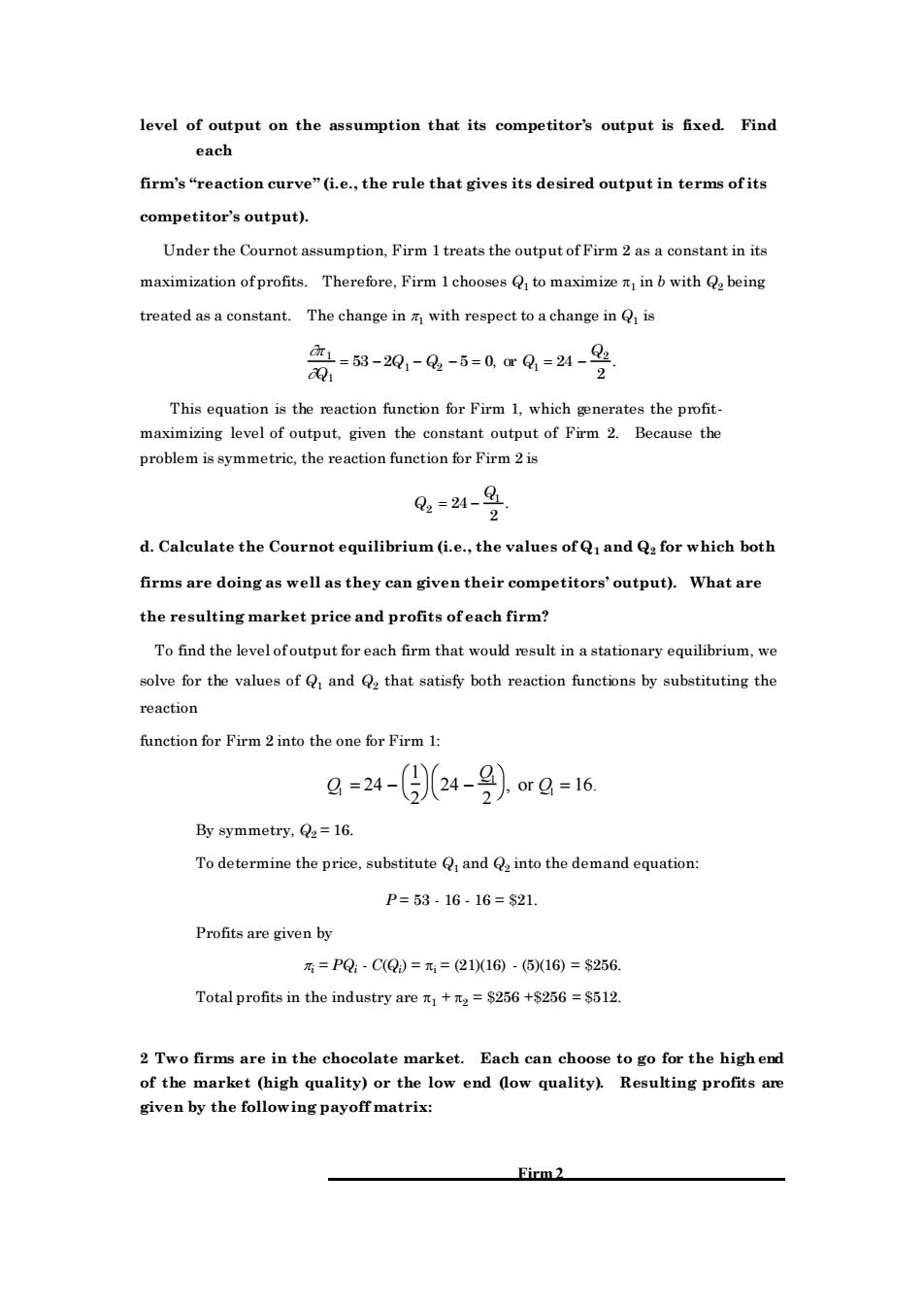正在加载图片...

level of output on the assumption that its competitor's output is fixed.Find each firm's"reaction curve"(i.e.,the rule that gives its desired output in terms ofits competitor's output). Under the Cournot assumption.Firm 1treats the output of Firm2as a constant in its maximization ofprofits.Therefore,Firm 1chooses to maximizeinb with being treated as a constant.The change inwith respect to a change inis =53-2,-,-5=0mg=24-号 This equation is the reaction function for Firm 1,which generates the profit maximizing level of output,given the constant output of Firm 2.Because the problem is symmetric,the reaction function for Firm 2 is ,=24- d.Calculate the Cournot equilibrium (i.e.,the values of Q and Q2 for which both firms are doing as well as they can given their competitors'output).What are the resulting market price and profits ofeach firm? To find the levelofoutput foreach firm that woul astationary equilibrium,we solve for the values of and that satisfy both reaction functions by substituting the reaction function for Firm 2into the one for Firm 1: 8=24-(924-g)rg=16 By symmetry,Q2=16. To determine the price.substitute and into the demand equation: P=53-16-16=$21. Profits are given by m=PQ-C(Q)=元=(21(16·(616)=$256. Total profits in the industry are +=$256+$256=$512. 2 Two firms are in the chocolate market.Each can choose to go for the highend of the market (high quality)or the low end dow quality) Re sulting profits are given by the following payoff matrix: level of output on the assumption that its competitor’s output is fixed. Find each firm’s “reaction curve” (i.e., the rule that gives its desired output in terms of its competitor’s output). Under the Cournot assumption, Firm 1 treats the output of Firm 2 as a constant in its maximization of profits. Therefore, Firm 1 chooses Q1 to maximize 1 in b with Q2 being treated as a constant. The change in 1 with respect to a change in Q1 is 1 1 1 2 1 2 53 2 5 0 24 Q 2 Q Q Q Q = − − − = , or = − . This equation is the reaction function for Firm 1, which generates the profitmaximizing level of output, given the constant output of Firm 2. Because the problem is symmetric, the reaction function for Firm 2 is Q Q 2 1 24 2 = − . d. Calculate the Cournot equilibrium (i.e., the values of Q1 and Q2 for which both firms are doing as well as they can given their competitors’ output). What are the resulting market price and profits of each firm? To find the level of output for each firm that would result in a stationary equilibrium, we solve for the values of Q1 and Q2 that satisfy both reaction functions by substituting the reaction function for Firm 2 into the one for Firm 1: Q1 = 24 − 1 2 24 − Q1 2 , or Q1 = 16. By symmetry, Q2 = 16. To determine the price, substitute Q1 and Q2 into the demand equation: P = 53 - 16 - 16 = $21. Profits are given by i = PQi - C(Qi ) = i = (21)(16) - (5)(16) = $256. Total profits in the industry are 1 + 2 = $256 +$256 = $512. 2 Two firms are in the chocolate market. Each can choose to go for the high end of the market (high quality) or the low end (low quality). Resulting profits are given by the following payoff matrix: Firm 2